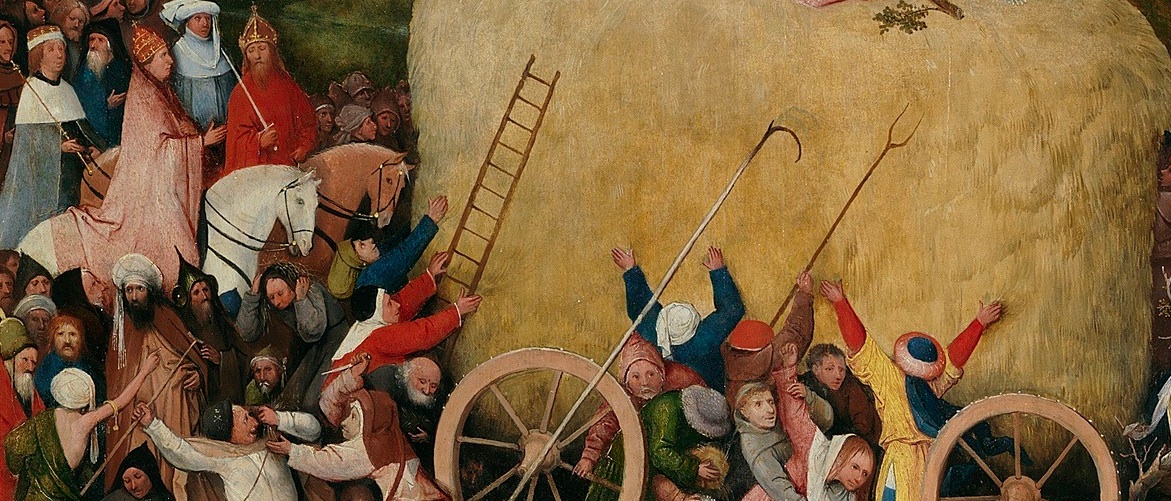The first question many ask when trying to understand a Jerome Bosch painting is, what sort of mind-bending drugs did they have in the late 15th-century? What unleashed this boundless imagination and surrealistic fantasy that inspired artists like Brueghel, Goya and Dali?
Last week an appointment in the southern Dutch city of ‘s-Hertogenbosch –Den Bosch–happened to bring me to the city’s market square where he lived from 1450 to his death in 1516. Two doors from the hotel where I had my meeting was a shoe store where many of his creations were painted over five centuries ago. Most of those paintings and drawings are now scattered around the world in major museums.
The city was a hive of activity, cleaning up after recent carnival frivolities and preparing for the opening of a major exhibition, Visions of a genius, to mark the quincentenary of the artist’s death. Although not so much as a single sketch remains in Den Bosch, this event is bringing ‘home’ most of his world famous masterpieces from around the globe: twenty paintings, nineteen drawings, plus various triptychs and panels. King Willem-Alexander was due the following day to open the ten-week event with a ceremony in the Saint John’s Cathedral (Sint Jan’s).
Jerome’s forefathers came from Aachen (Aken) in Germany across the border, settling in Den Bosch in 1426, then an important economic, cultural and religious hub. Father Antonius van Aken, named after the desert father, had his son christened Hieronymus van Aken after another famous desert father, Hieronymus or Jerome. (These two saints would become recurring themes in his artwork.) Later, following the practice of many artists and scholars in the Middle Ages, Hieronymus changed his last name to ‘Bosch’ after his hometown.
Hallucinogenic?
On the cathedral square I found myself walking among strange recreations from Bosch’s fertile mind that over the coming months will hang from lampposts and erupt from pavements: angels, demons, giant ears, mermaids riding on flying fish, drunken priests, lascivious women, and monsters with the legs of a giant chicken and the body of an egg.
So where do we begin to decipher the work of this man which has been described as pornographic and induced by hallucinogenic sources? The Garden of Earthly Delights, for example, depicts a dream-like vision of naked men and women engaging in all sorts of foolish and profane behaviour. So it may surprise us to learn that this work was probably commissioned by Hendrik III, Count of Nassau, entrusted with the education of the future Emperor Charles V.
More surprising may be that Bosch himself was a man of deep faith closely associated with the renewal movement of the early Renaissance, the Brothers of the Common Life. The brotherhood, originating in late 14th-century Netherlands, promoted a personal devotional lifestyle called Devotio Moderna, focused on the teachings of Christ. The most famous book of this movement was Thomas a Kempis’ The Imitation of Christ.
The brothers pioneered education for all, rich and poor, so they could read and develop their own relationship with God, to choose for good rather than evil, to take responsibility for their own actions, and to grow in personal perfection in imitation of Christ.
Bestiality
In Bosch’s surreal oeuvre, the fight between Good and Evil forms a central theme, expressed in a visionary imagery rooted in the popular culture of the times. So what was the Count of Nassau supposed to conclude from the tryptich hanging over his king-size bed in his Brussels palace? Namely: that the children of Adam and Eve achieve only carnal knowledge in materialism and sensualism, and confuse the senses for true spirituality; that ‘earthly delights’ with their short-term rewards should be denied in favour of the eternal good.
Bosch’s intentions can be more clearly understood in, for example, Christ Carrying the Cross. This crucifixion scenario shows Christ surrounded by grotesque faces of his tormentors, revealing the bestiality of those who choose evil. The Haywain (haywagon) also shows the vanity of earthly wealth, echoing the warning from Thomas a Kempis that sin comes from attachment to the earthly realm–a central subject of all Bosch’s paintings.
On the top left of the painting above we see the Duke of Burgundy, Pope Julius II and the Emperor all chasing worldly wealth, surrounded by frenzied individuals desperate to grab their share. Yet in a cloud high above the whole scene the risen Christ is ignored by all except one worshipping angel. Bosch portrays in timeless art what Thomas a Kempis set in immortal words: It is vanity to seek and trust in riches that perish. It is vanity to court honour and to be puffed up in pride. It is vanity to love what passes quickly and not to look ahead where eternal joy abides. Turn your heart from the love of things visible and bring yourself to things invisible’.
Till next week,




[…] for the first time ever. Bosch was strongly influenced by the Modern Devotion movement, as I wrote earlier, and dealt with themes of good and evil, virtue and sin, heaven and hell in surprising and […]
[…] fueron expuestas por primera vez en su ciudad natal, Den Bosch. Como ya lo había dicho en otra reflexión, El Bosco fue fuertemente influenciado por el movimiento de la Devotio Moderna, que trataba sobre […]